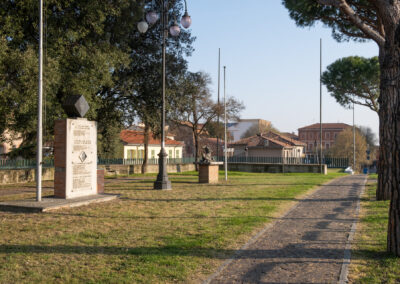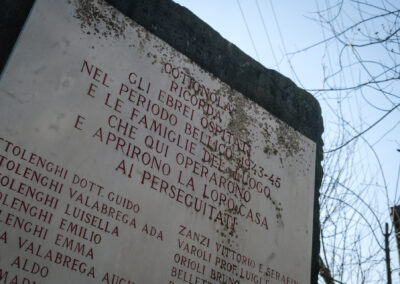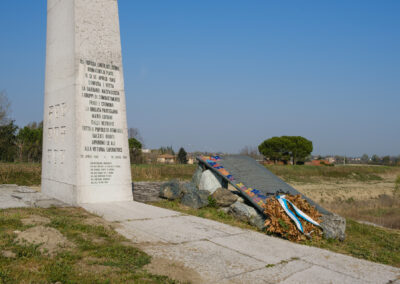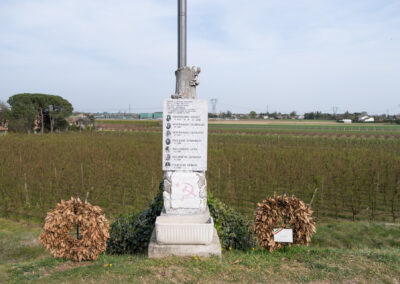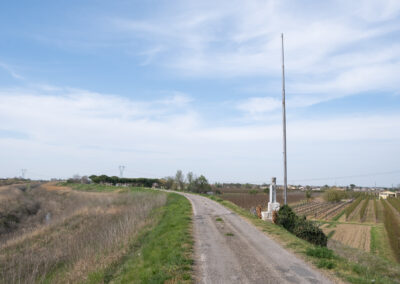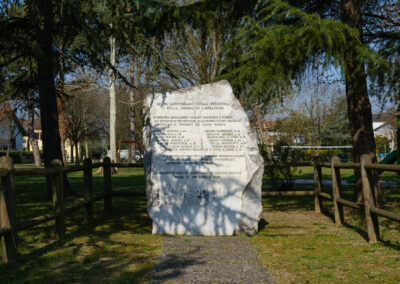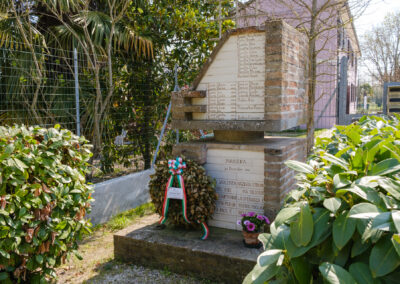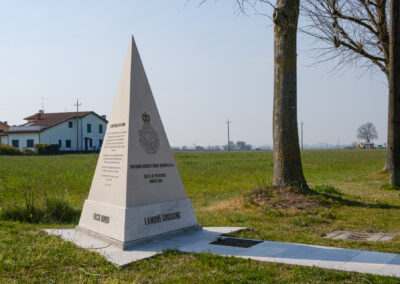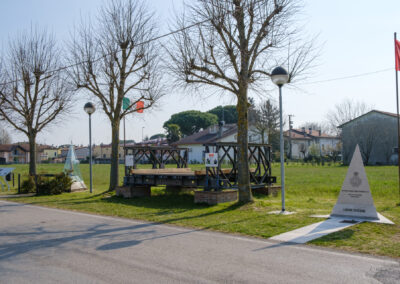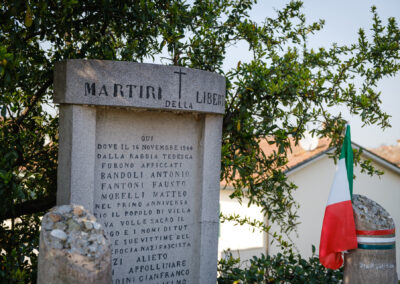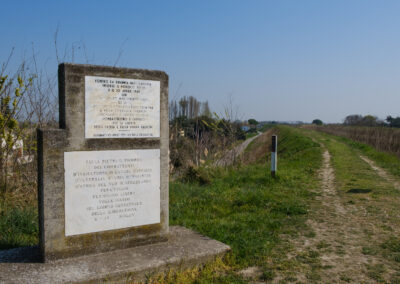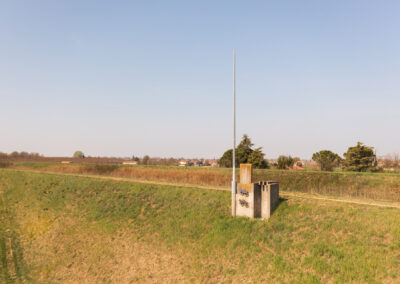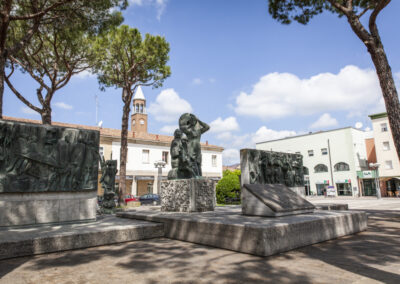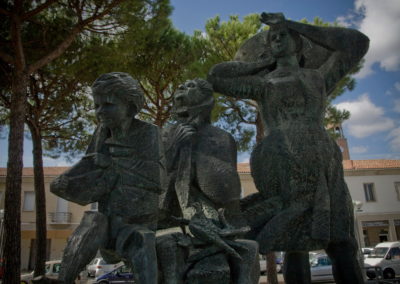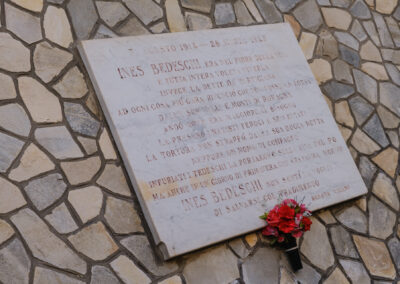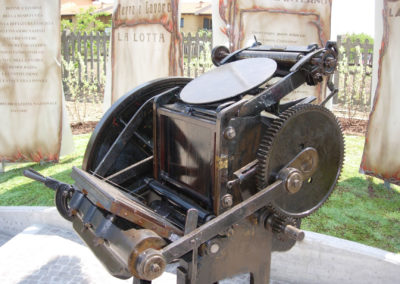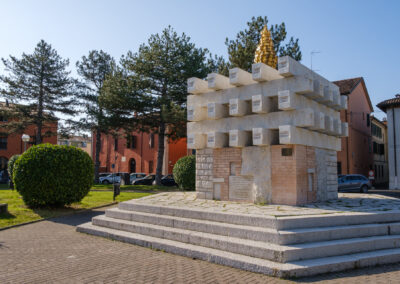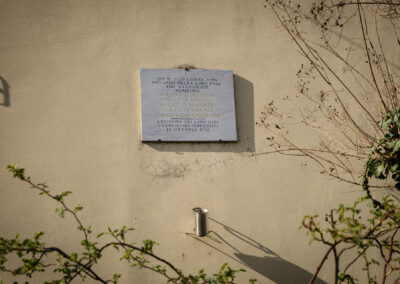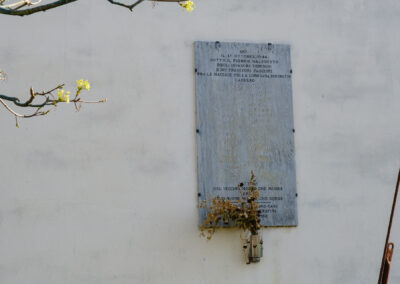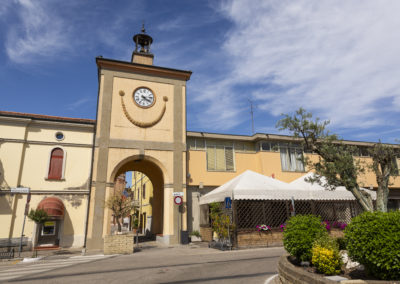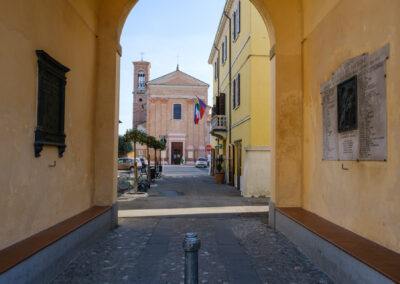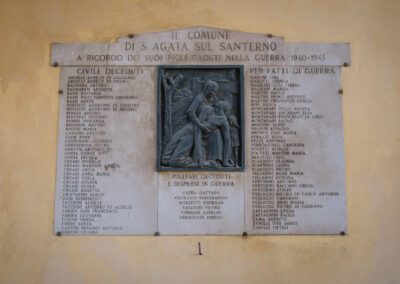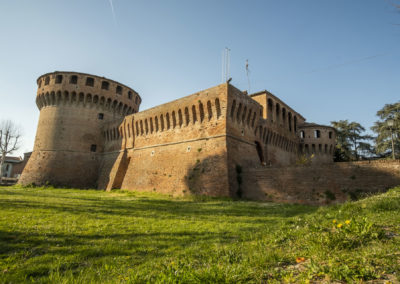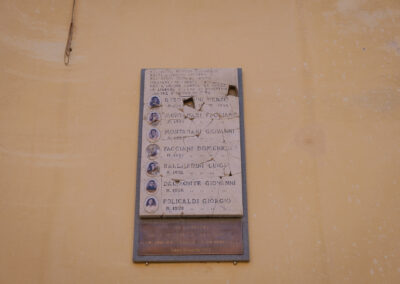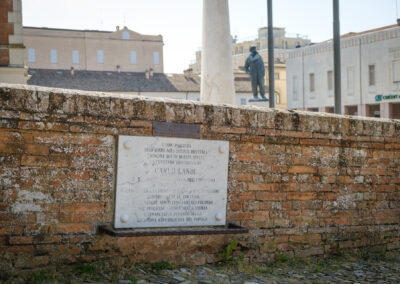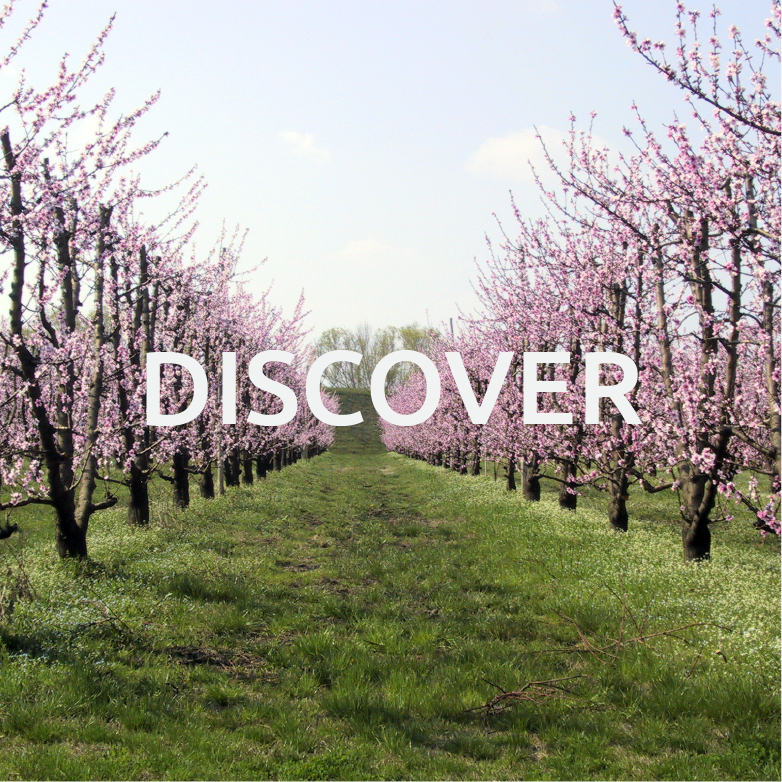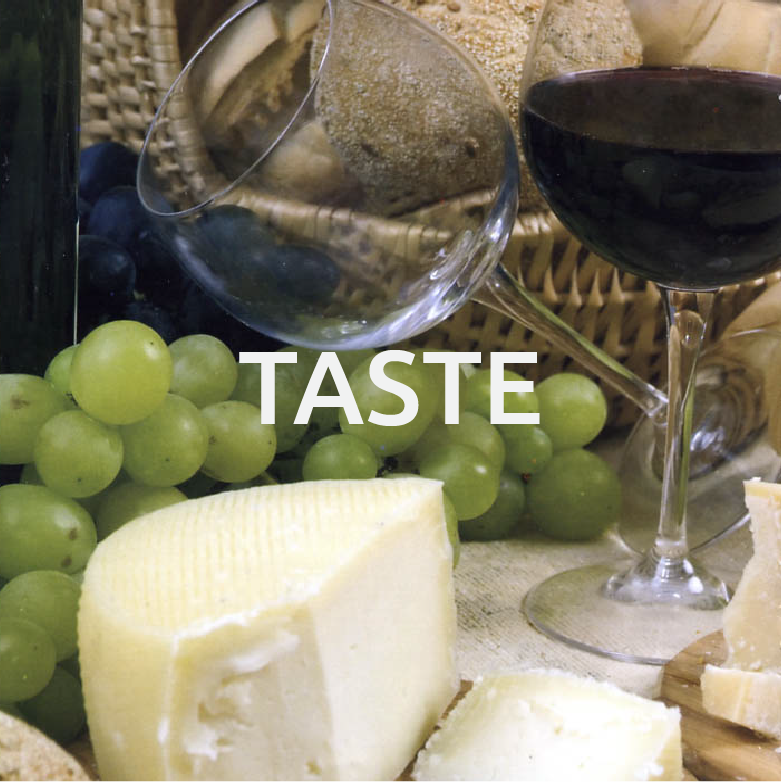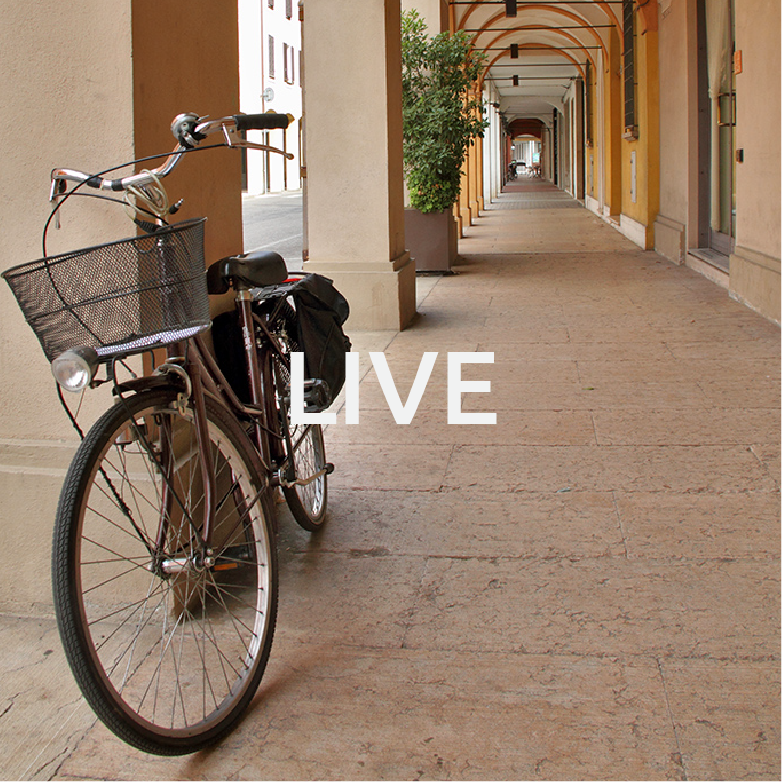The “Landscape memory” itinerary is a route through the territory that was a strategic location during the last stages of the Second World War. We are now going to explore the stories linked to some of the memorial stones, steles and monuments as they appear along the itinerary.
The itinerary starts in Cotignola and continues along the adjacent embankment of the Senio river, which you can take a detour to Bagnacavallo, Fusignano and Villanova di Bagnacavallo, as far as Alfonsine. From here we cross the countryside to Conselice, then Massa Lombarda and Sant’Agata sul Santerno, and finally, after a diversion to Bagnara di Romagna, we head to Lugo and return to Cotignola. You can travel by bike or by car, following the directions on the map available at this link.
For further information on the memorial stones, we recommend the project “Le pietre della memoria” (the stones of memory), carried out by Istituto Storico della Resistenza e dell’Età Contemporanea in Ravenna e Provincia (Historical Institute of the Resistance and Contemporary Age in Ravenna and its province).
Cotignola
- Monument in memory of the New Zealand Liberators and the “White Flag” operation, located at Parco della Resistenza, via Lungo Senio del Fronte. The monument consists of two bilingual plaques in Italian and English. The first one honours the soldiers of the 2nd New Zealand Division, part of the 8th British Army, who, on 10th April 1945, freed Cotignola, the hardest hit town along the Senio river. The second plaque recalls the moment when the Allies, believing that Cotignola was still in German hands, were about to keep on bombing. The parish priest Don Stefano Casadio and the communist partisan Luigi Casadio “Leno”, vice military leader in the area, stopped them, crossing the Senio river waving a white banner and informing the Allies that the few remaining Germans had already been disarmed and taken prisoner by the Resistance forces.
- Memorial Stele in the Giardino dei Giusti (garden of the Righteous), Strada Provinciale 19: the stele, inaugurated on 26th April 1987, bears the names of the Jews sheltered in Cotignola and those who gave them refuge. The stele is surrounded by a grove of 41 trees (as many as the number of the Jews rescued) with a cedar of Lebanon in the centre, a tree that symbolizes Israel, in front of which lie six large stones to represent the 6 million Jews killed in the Shoah
Lugo
- Memorial stone in memory of the offensive of 10th April 1945, located along Senio river embankment, via Chiusa – via Confini di Lugo. The memorial stone, erected on 25th April 1954, is located near the Senio river embankment from where, on 10th April 1945, the Allies started their decisive offensive against the last bulwarks of the Gothic Line. Commissioned by the Provincial Administration in agreement with the Associations of Fighters, Partisans, the Fallen, the Mute and the Civil War Invalids, it bears an epigraph dictated by the illustrious philologist Manara Valgimigli (1876-1965), one of the signatories of the Manifesto of Anti-Fascist Intellectuals drawn up by Benedetto Croce. In 2005, a bronze slab was added at the foot of its base in memory of the deminers who fell in the Senio Valley.
- Memorial stone in memory of the Martyrs of Senio river, located along the Senio river bank, via Confini di Lugo. The memorial stone placed here today is a copy of the original one that was vandalised in March 2012 (the original one is located inside the courtyard of the Rocca Estense in Lugo) and is in memory of the seven very young boys slaughtered by the Nazis on the Senio river bank on 26th October 1944. Between the 23rd and the 24th of October, nine young people belonging to the Fronte della Gioventù (the youth organization of the Italian Communist Party) were arrested in the surroundings of Lugo during a round-up by the Black Brigade. Taken first to the Casa del Fascio (from which one managed to escape), then to the fortress prison, they were tortured. On the morning of 25th October, Carlo Landi “Matto”, was found massacred on the entrance steps of the Rocca (where a plaque now commemorates him). The black brigades, after stealing cash from the Bank of Italy branch (a prelude to their escape northwards), handed the seven young men over to the Germans, who, at dawn on 26th October, took them to the Senio riverbank and shot them with an anti-aircraft machine gun, throwing their bodies into the river. The remains of three of them were never found.
- Plaque to the Deminers, Senio river embankment: the plaque celebrates the end of the demining of the Senio river in 1949, paying tribute to those “silent men who every day fought a private war against an absurd and hidden enemy; every evening someone did not answer the call”.
Bagnacavallo
- Stele of Jewish refugees and deportees from Bagnacavallo, Parco della Pace, via delle Regioni 8. The town welcomed Jewish refugees from Fiume, Hungary and Romania, who were protected by a tight network of solidarity. Unfortunately, after leaving Bagnacavallo, not all of them were able to avoid arrest; 14 of them found their death in the Nazi extermination camps. The stele, inaugurated on 25th of April 1995, remembers their sad end, joining their memory to that of the brave families of Bagnacavallo who gave them hospitality.
Antonio Dalla Valle and the Tambini family (Aurelio and Amelia and their children Vincenzo and Rosita) were part of a chain of rescuers who, in Bagnacavallo, saved the life of the Jewish Weiss Galandauer family, who had fled from Fiume on 13th September 1943 when the Germans arrived (Dalla Valle and the Tambini family were awarded the title of Righteous Among the Nations by Yad Vashem in Jerusalem in 1974). There were nine Weiss Galandauer family members: Laura Weiss, her daughter Sara Jakobovitz with her two children (Oscar aged 13 and Edda aged 11), her second daughter Elena with her husband Giacomo Galandauer and their three children (Eugenio, Cecilia and Antonia). The Jewish family stopped in Bagnacavallo during their escape to central Italy and rented two rooms and a small kitchen on the second floor of the Tambini family’s house. Marshal Ezechiele Maccacaro, commander of the Carabinieri station of Bagnacavallo and friend of the family, warned them about the impending Nazi-fascist raids. The Weiss Galandauer’s were helped by the Tambini family to escape and were welcomed by Antonio Dalla Valle, a roadman from Bagnacavallo, who gave them hospitality for a month in his house and dug a shelter on the Senio riverbank connected by a tunnel to the house where the fugitives could hide in case of need. The nine members of the Weiss Galandauer family then managed to escape from Italy and cross the Swiss-Italian border. - Memorial stone in memory of the massacre of Masiera on the 23rd December 1944, Masiera di Bagnacavallo, via Sotto Fiume Destra. The memorial stone remembers the terrible massacre of Masiera, which took place in the night of the 23rd December 1944, when the Germans mined some civilian houses located close to the Senio river bank – the Galassi, Pignatta and Costa’s (constituting the so-called “Borgo Pignatta”) houses – where some shelters had been built to host also members of other families. Twenty-eight people perished in the explosions, including old people and children. Since the Germans deliberately stopped any rescue, their remains were recovered only after the breakthrough of the Senio river line.
Villanova di Bagnacavallo
- Monument to the Canadian soldiers, via Chiesa: in front of the Canadian War Cemetery is a section of the Bailey bridge that the Allies set up in order to cross the Lamone river.
- Memorial stone of Villanova, via Chiesa: the monument, dedicated to the fallen of Villanova in the Second World War is the creation of the sculptor Enzo Babini from Cotignola and was inaugurated on 16th November 1994 on the fiftieth anniversary of the massacre of the “Three Martyrs“.
- Stele of the Battle of the Rivers, via Chiesa: the stele commemorates when, at the end of November 1944, the Governor General’s Horse Guards – GGHG (3rd Armoured Reconnaissance Regiment, 5th Canadian Armoured Division) – arrived in Ravenna. On 2nd December they took part in the Battle of the Rivers, which continued in January 1945, crossing the Montone, Lamone, Munio and Senio rivers. On 11th February 1945, the regiment ended its stay in Italy and left for Holland. Seven soldiers of the GGHG rest in the cemetery of Villanova.
- Three Martyrs’ Memorial Stone: the stone is dedicated to the young Antonio Bandoli, Fausto Fantoni and Matteo Morelli, who were hanged by the Nazis on the bank of the Lamone river on 16th November 1944, in retaliation for the killing of a German soldier.
Fusignano
- Stele in memory of the Cremona Fighting Group, the 28th Garibaldi Brigade and the Commonwealth fighters of the 8th British Army, Senio river embankment bridge. The memorial stone has two different plaques: the first, at the top, placed on 10th April 1959, commemorates the breakthrough of the front in this area by the soldiers of the Cremona Combat Group and the partisans of the 28th Garibaldi Brigade “Mario Gordini”. The second, below, walled up on 10th April 1965, commemorates the soldiers of the various Commonwealth nationalities who served with the British 8th Army.
- Stele in memory of Seno river crossing, Senio riverbank, Rossetta: the concrete structure is similar to a lookout post and bears an inscription with bronze characters. The inscription recalls the point where the military crossed the Senio river. The river marked the front line for many weeks in the winter of 1944-45. The stele is flanked by a flagpole and stands at the point where, at dawn on 10th April 1945, the soldiers of the Cremona Combat Group crossed the banks of the Senio river, thus starting “Operation Sonia” and the subsequent breakthrough of the last bastions of the Gothic Line. Around noon the 3rd Battalion of the 22nd Regiment of Cremona reached Fusignano still garrisoned by some German Tiger tanks.
Alfonsine
- Monument to the Martyrs of the Resistance and to Freedom Volunteers Corps, piazza Antonio Gramsci: the monument bears witness to the population’s commitment to the struggle for liberation. The work, by Faenza sculptor and ceramist Angelo Biancini (1911-1988), was created between 1970 and 1973. The Triumph of the Resistance consists of a central group dedicated mainly to women, with the figure of a mother and young daughter waiting for the men who had left to fight the Nazi-Fascists, with a child in their arms. On the sides, two bronze high-reliefs applied on stone walls depict on the left, a group of armed partisans descending from the Apennine mountains to meet the population of the plains, and on the right, the meeting between generations to transmit the terrible memory of war and the values of resistance. The resurrected victims and children “coming out of the cave” holding a dove, symbol of Peace, are also depicted. The passage leading to the final part is decorated with shattered symbols of battles, to remind us of the legacy of war, and culminates in a great Nike triumphing, shouting through tongues of flame, to announce the day of Victory and Liberation. A large central epigraph was dictated by partisan commander Luigi Longo.
Conselice
- Plaque to Ines Bedeschi, via Garibaldi 31. Ines Bedeschi (31/8/1914 – 28/3/1945) was born in Conselic; daughter of a farmers’ family, a Gold Medal was awarded in order to pay tribute to her memory. She was a relay girl with the name of “Bruna” and coordinated the activities of partisan groups in the Lugo area and liaised between the fighters in the Apennines and the clandestine fighters operating in the towns on the plain. Her last mission, just one month before the Liberation, took her to Parma, where she was discovered, tortured by the Nazi-Fascists and thrown into the Po river. Her body was never found.
The story of Ines and the other partisan relay girls active in this area inspired the director Giuliano Montaldo for the film “L’Agnese va a morire” (1976, screenplay by Renata Viganò based on her novel with the same name. Renata Viganò was responsible for the text of the plaque).
Massa Lombarda
- Monument to the Fallen Partisans of Massa Lombarda, piazza Umberto Ricci: The monument was erected in the early post-war period to commemorate the many victims of the Nazi-Fascists of Massa Lombarda who were killed in the town and countryside or during clashes between partisans and the Nazi-Fascists throughout the province. The monument commemorates 50 people.
- Tombstones in memory of the Baffè and Foletti families, via Martello 1 and 2. On 17th October 1944, one of the fiercest and most terrible massacres took place in the province of Ravenna, in which 23 people belonging to the Baffè and Foletti families were killed, together with friends, occasional guests, neighbours and employees.
On the night of 16th October, dozens of Nazis and Fascists in lorries, coming from Lugo and Sant’Agata, headed towards the outskirts of Massa Lombarda for a targeted round-up that included the Baffè family, known for its commitment to the anti-Fascist struggle, but along the way they were intercepted by a group of Gappisti who engaged them throughout the night and a German officer and a partisan died in the clash.
On the morning of 17th October 1944, German soldiers and fascist militia from Lugo and Massa Lombarda burst into Baffè’s house and the men, together with seven other civilians rounded up from the surrounding area, were taken by force to the prison of Palazzo Armandi, headquarters of the Black Brigades of Massa Lombarda. Then the men were brought back and shot while the women perished under the rubble of the house that had been blown up with mines. A bilingual sign in Italian and German was put up by the executioners on the walls of the house and read: “A family of partisans and murderers lived here”. (The building, on which the plaque is visible, was rebuilt in 1951). Shortly after the massacre of the Baffè family, the Nazi-Fascists moved into the yard of the farmhouse opposite, belonging to the Foletti family, killing the four male members of the family and the farmhand Giuseppe Cavallazzi. The house was sacked and set on fire; it was rebuilt after the war. (The plaque was placed on 17th October 1952 by the surviving family members).
Sant’Agata sul Santerno
- Tombstones to the Fallen of the First and Second World Wars, Piazza Umberto I. The tombstones are displayed inside the vault of the Clock Tower. The plaque that commemorates the Fallen of the African Campaign (1911-1912) and the Fallen and Missing of the First World War, is made of bronze from the casting of captured enemy cannons. The plaque opposite commemorates those who died in Sant’Agata during the Second World War.
Bagnara di Romagna
- Monument to the Fallen, piazza IV Novembre 7. The plexiglass and bronze monument celebrates the civilian and military dead of the two world wars. The bronze slabs currently placed here were part of a more complex work in memory of the fallen, also consisting of white marble plaques, placed against the wall of the Rocca di Bagnara in 1927.
Lugo
- Plaque dedicated to Carlo Landi, Rocca (fortress), Piazza Martiri della Libertà. The plaque is located on the small wall to the right along the entrance ramp to the Rocca and commemorates one of the many episodes of cruelty committed by the fascist squads, the killing of twenty-year-old Carlo Landi “Matto”.
Slab to the deported Jews, Rocca, piazza Martiri della Libertà: the slab is placed at the entrance of the Rocca and commemorates Lugo’s Jewish families, deported and exterminated by the Nazis between 1940 and 1945. - Memorial stone to the Martyrs of the Senio river, Rocca (fortress), Piazza Martiri della Libertà. On the right wall of the Rocca’s courtyard, fragments of the original memorial stone, vandalised in March 2012, have been reassembled in their original location (Senio river bank, via Confini di Lugo). The memorial stone pays tribute the seven young boys slaughtered by the Nazis on the Senio river bank on 26th October 1944. Between the 23rd and the 24th of October, nine young members of the Fronte della Gioventù (the youth organisation of the Italian Communist Party) were arrested in the surroundings of Lugo during a round-up by the Black Brigade. Taken first to the Casa del Fascio (from which one managed to escape), then to the Rocca prison, they were tortured. On the morning of 25th October, Carlo Landi “Matto”, was found massacred on the entrance steps of the Rocca (where a plaque now commemorates him). The black brigades, after stealing cash from the Banca d’Italia branch (a prelude to their escape northwards), handed the seven young men over to the Germans, who, at dawn on 26th October, took them to the banks of the Senio river and shot them with an anti-aircraft machine gun, throwing their bodies into the river. The remains of three of them were never found.
(Updated to 16/05/2021)

